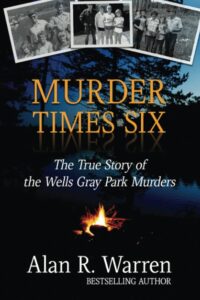Murder spree: ‘a means to an end’
Murder Times Six: The True Story of the Wells Gray Park Murders
by Alan R. Warren
Self-published, 2020
$20.00 / 9781989980132
Reviewed by Matthew Downey
*

When venturing out into one of the many enormous patches of wooded wilderness that blanket British Columbia, issues of safety and preparedness necessarily must be considered. If one travels, whether on foot or wheels, through the dense bush isolated from human society by hundreds of kilometres, there are innumerable natural dangers that may threaten—from Grizzlies, wolves, and cougars to rattlesnakes, ticks, and poison oak.
A terrifyingly unnatural danger not often expected, due to its rarity and horrific abnormality, is any human-authored danger encountered out in the bush. That’s the subject of Alan R. Warren’s Murder Times Six: the brutal killing of three generations of holidaymakers, the difficulty of solving their case due to the isolation of the events, and the struggle with how the Canadian justice system must in perpetuity deal with the twisted perpetrator.
In August 1982, David Shearing (now known by the surname Ennis) assaulted and murdered Bob and Jackie Johnson, with their two young daughters Janet and Karen, alongside Jackie’s parents George and Edith Bentley, while the family was camping in Wells Gray Park near Clearwater, BC. After an elusive investigation that included a cross-country police publicity tour and numerous misleading tips, Shearing was apprehended in Tumbler Ridge as he stole machinery while living in a ramshackle work camp.
As a radio host, with programmes heard throughout the western United States, and a bestselling author with two dozen books under his belt, Alan R. Warren (Beyond Suspicion) is no stranger to narrativizing real-life cases and imbuing the story with suspense. What is notable about Warren’s take on the Johnson-Bentley murders is the way in which he emphasizes the family, the community, and prioritizes an opinionated compassion in providing his analysis on the case. Warren treats the notoriety of Shearing with some care; he highlights the permanence of the damage Shearing caused by drawing on comments from the victims’ family and others involved in the case. A rare endearing episode in the book involves RCMP constable Ron German, who first apprehended Shearing. Warren relates the way he found friendship with the family after he attended an event held in tribute of the Johnson and Bentley clan.

Warren places the Wells Gray murders in a thoroughly North American framework. The perspective is most appropriate when making comparisons with killings of a like brutality that happened south of the border–such as those of the BTK Killer in Kansas. However, for a Canadian reader it proves somewhat distracting when the text is peppered with Americanisms. It is excusable to be subjected to American English spellings considering the book’s country of publication, but descriptions of British Columbian court that fail to capitalize ‘the crown’ and make reference to Shearing’s ‘defense attorney’ almost cause one to forget that President Polk was unsuccessful in his 51/40 campaign in the 1840s, and that we are not currently living in the American republic–perhaps some metastasized rendition of the Alaskan panhandle that has spread from the Pacific shore to the Rocky Mountains.
Despite those missteps, Warren does firmly root Murder Times Six in a commentary on the Canadian system’s handling of the imprisonment and parole of convicted killers. Concurrently, Warren discusses the psychology of people like Shearing who target minors for assault. By matching a picture of the route for supposed redemption and release that is available for those convicted of violent crime in Canada, and the sordid psychological milieu of killers of Shearing’s kind, with the harrowing impact on the families and friends of victims, Warren raises the important question of the social impact of release.
Warren tasks the readers with considering whether they would want someone who has done what Shearing has done living in their neighbourhood next to their children. How tightly to control criminals is important topic of discussion in BC at the moment, as alongside a growth of publicized violent crime is a growth of criticism of Canada’s ‘catch and release’ bail system. Warren’s outsider perspective is therefore quite prescient, as is his humanizing focus that takes into account social impact and the victims feelings as it delves into the person of Shearing.

Warren’s social perspective is enriched by his dealings with the topic of Shearing’s own personal relationships. Shearing’s immediate family–his mother and siblings–are referred to in due course, but what is most interestingly dwelt upon is his marriage. Shearing married his wife, whom he met while in prison, after nearly two decades as a convict. As Warrant describes it, Shearing lives a semblance of a healthy domestic life with his wife, enjoying multiple overnight visits a month. The Christian faith of Shearing’s wife, which she has apparently led him to espouse as well, causes her to emphasize forgiveness and the change of heart he is due.
Warren casts a dim light of doubt on this assertion, coloured by the painful irony that Shearing is now enjoying a level of domesticity that he denied to the six people he killed. The lack of sympathy that Warren has for Shearing’s desire to live freely on the word of his forgiving wife is developed by a degree of investigation into the phenomenon of women who seek out convicted killers, begin romantic relationships with them, and at times marry. If Warren’s description of the potential psychological causes (and the sometimes lethal consequences) of those women’s generous mentality towards violent killers seems dismissive of Shearing’s wife and the authenticity of her faith, he does finds a prospective reason for their relationship in the mental condition hybristophilia. Nevertheless, Murder Times Six remains rooted in an overall sympathy for Shearing’s victims that largely defines the narrative.
Warren’s investigation into the Wells Gray murders is steeped in personality, giving character to his commentary on the Canadian judicial system that is unique and empathetic in its insights. In a regionalized case of a murder that occurred in the heart of British Columbia, deep in its rural country, Warren asks his readers to draw upon universal empathetic feelings of disgust at the crimes of Shearing and sympathy for those impacted.
*

Matthew Vernon Downey is an independent writer and researcher based out of Victoria, BC. He has degrees from UVic (BA hons) and the London School of Economics (MSc) [Editor’s note: Matthew Downey has also reviewed books by Gregor Craigie, Robert Crossland, Donna (Yoshitake) Wuest with Joe W. Gardner, Mike Whalen, D.C. Reid, Alexander Globe, and Angus Scully for BCR.]
*
The British Columbia Review
Interim Editors, 2023-25: Trevor Marc Hughes (non-fiction), Brett Josef Grubisic (fiction and poetry)
Publisher: Richard Mackie
Formerly The Ormsby Review, The British Columbia Review is an online book review and journal service for BC writers and readers. The Advisory Board now consists of Jean Barman, Wade Davis, Robin Fisher, Barry Gough, Hugh Johnston, Kathy Mezei, Patricia Roy, Maria Tippett, and Graeme Wynn. Provincial Government Patron (since September 2018): Creative BC. Honorary Patron: Yosef Wosk. Scholarly Patron: SFU Graduate Liberal Studies. The British Columbia Review was founded in 2016 by Richard Mackie and Alan Twigg.
“Only connect.” – E.M. Forster
One comment on “Murder spree: ‘a means to an end’”